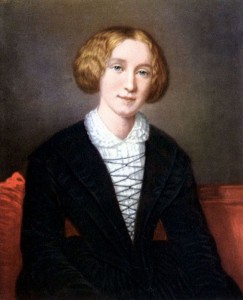
George Eliot, the mask of a woman who didn’t fit the Victorian stereotype.
Mary Anne Evans (1819-1880) was born on a British Protestant farm and after having read numerous works on theology, she had found inconsistencies. At the time, Mary Anne realized that she wasn’t cut out for being a mother. However, strict Victorian standards held that women should be wives, mothers and fervent religious devotees, occupying themselves as housewives. By the end of 1841, Mary Anne was already agnostic.
In 1844, Mary Anne translated Das Leben Jesu by Friedrich Strauss from German into English. The translation took her two years and the author was stunned by its precision. Mary Anne received ₤ 20 for the two years of work. In 1846 John Chapman published this translation.
In 1849 Mary Anne’s father, a devote protestant, passed away. In 1850 John Chapman was asked to do a book review for the newspaper The Westminster Review. Mary Anne moved to Chapman’s house in London, where he lived with his wife and her lover. Chapman and Mary Anne quickly became lovers, but Mary Anne wasn’t accepted by the other two women, and therefore she had to move.
In 1851 John Chapman needed an editor for The Westminster Review. Mary Anne accepted the post without pay. During her two years of work, she met the journalist George Lewes. George was married to a woman by the name of Agnes Jervis on paper, but in reality she was the lover of one of his best friends, with whom she had five children. George and Mary Anne fell in love, but kept their relationship a secret.
In 1854 Mary Anne translated the one of Ludwig Feuerbach’s works Essence of Christianity. Upon finishing the translation, Chapman asked her to begin working for the newspaper again, this time to be in charge of a section on literary criticism. George encouraged her to write fiction and in 1856, she wrote what would be known as Scenes of Clerical Life, published under the pseudonym George Eliot. Mary Anne wanted to be taken seriously as a writer and not as a romance novelist (like many female writers at the time), which is why she chose the pseudonym: George, after her lover, and Eliot because it was easy to pronounce. Moreover, her real name was already well-known and was associated with the controversial relationship that she had with Lewes. The name George Eliot allowed Mary Anne to receive critique based on her work and not on her private life.
Scenes of Clerical Life was a great success and the start of a brilliant career as a writer. In 1859 she published Adam Bede. As soon as Queen Victoria praised this new work the sales went through the roof. She soon let the true identity of George Elliot be known and continued writing for the next 16 years, earning a fortune for her work. Her book Middlemarch alone yielded ₤9,000.
When Charles Dickens passed away in 1870, George Elliot (Mary Anne Evans) was declared the greatest British writer of her time.
To consult the original post click here:
Comienzo de la traducción profesional: George Eliot
